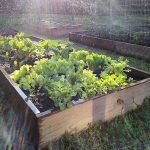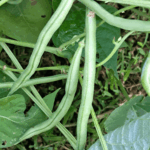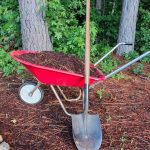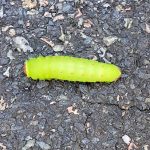Learn how to grow kale in Virginia, zones 6 and 7, in both spring and fall, using organic gardening techniques.
Kale Plant Profile
Common Name: Kale
Botanical Name: Brassica oleracea var. acephala
Kale can be grown in Virginia, gardening zone 7B, spring and fall. Our spring crop survived the winter and continues to thrive, while the fall crop is just starting to get big enough to harvest.
Light Requirements: Full sun to partial shade.
Soil: Kale prefers a slightly acidic to neutral pH (6.0 to 7.5) and rich, loamy soil. Whenever we plant a bed of kale, we add mushroom compost and garden compost to the soil to ensure it has plenty of nutrients.
Water: Keep soil consistently moist but not soggy. The usual advice of one inch of water per week, either from rain or irrigation, satisfies kale’s water needs, too.
Fertilizer: I don’t add any fertilizer; if you start with good compost mixed into the soil, you probably do not need any additional fertilizer. Gardeners not concerned with organic gardening practices can add 10-10-10 to the soil when planting kale and side-dress with high nitrogen (high middle number, like 5-10-5 or 10-20-10) every six to eight weeks during the growing season.
How to Grow Kale: Starting Kale from Seeds
I prefer to grow kale directly from seed. Start with the right variety – for years I tried to grow the varieties I grew on Long Island (Zone 6) with little success. It wasn’t until I saw my neighbor’s giant, beautiful heads of kale that I asked what variety he grew and he recommend “Lacinato.” It grows very well here in Virginia, survived the summer’s heat, and continues to produce abundantly in the fall, so it is now our go-to variety.
Sow kale seeds directly into the raised bed soil. Push the soil lightly over the seeds. Water immediately, and water daily until the seeds germinate. Keep the weeds in check by pulling them by hand.
Harvesting Kale
You can harvest kale when the plant has at least two or three sets of leaves. It’s fine to snip the small leaves off for salads. Just don’t over-harvest the leaves on a young plant. Ensure the plant has at least two sets of leaves to thrive. Larger leaves can be snipped entirely from the stem or pulled gently by hand.
Kale Pests and Diseases: Cabbage Moths
Cabbage moths love to lay their eggs on kale leaves. The larvae hatch, and cabbage worms hide among the leaves, chewing holes through them and on the edges. If you spot the larvae, pull it over and discard it. The best organic control methods are b.t. (Bacillus thuringiensis, a natural bacteria that attacks the larvae) or hand-picking them off. Insect cloth provides a natural barrier that allows water and sunlight to reach the leaves but keeps the moths from laying their eggs on the kale.
Other pests that can attack kale include flea beetles and aphids, but I find their attacks are minimal. The cabbage worm or larvae can destroy kale, leaving behind a lacy green mess, and are my nemesis in the garden!




